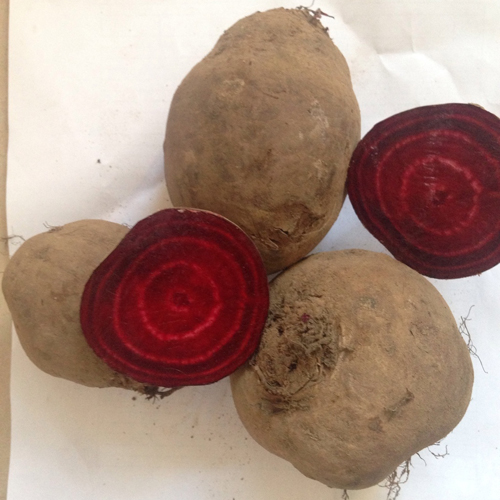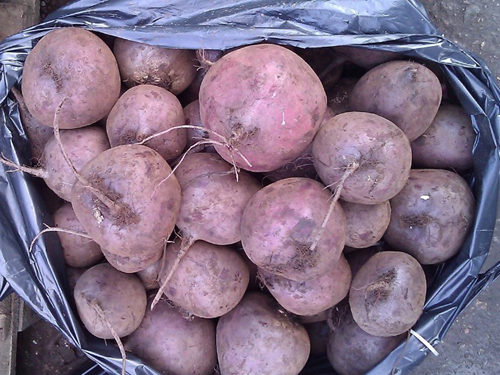Beet variety Bordeaux 237
Beetroot has always been and remains a traditional vegetable of Russian national cuisine, so beet beds can be found in almost any vegetable garden. One of the most popular and time-tested varieties is Bordeaux 237, created in 1937. The applicant was the Federal State Budgetary Scientific Institution "Federal Scientific Center for Vegetable Growing". This beet was included in the State Register of Breeding Achievements of the Russian Federation almost 6 years later - in 1943. Suitable for growing in all regions of Russia. Over the years of cultivation, it has gained popularity in Moldova, Belarus and Ukraine. Not a hybrid. Purpose - for open ground.

Description
The leaf rosette is semi-standing, of medium size, and looks compact. The leaf is wide, oval, with a wavy edge. The color of the plate is green, with pronounced veins colored with anthocyanins. The surface is glossy, slightly bubbly. The petiole is long, with a predominance of anthocyanin coloration, therefore it has a bright dark pink hue.
Beetroot vegetables look attractive. The shape is round or round-flat. Diameter is from 12 to 15 cm. The weight of a commercial vegetable is 232 - 513 grams. The skin is dense, elastic, matte, dark red. There are few thin roots. The pulp is dense, tender, juicy, has a high sugar content, intense dark red color. On the cut, it is homogeneous, with a barely noticeable ringing. Bordeaux 237 has excellent taste. The seeds are large - 2 - 4 mm, similar to dark brown polyhedrons.

Characteristics
- The variety belongs to the medium early - the period from germination to the onset of technical ripeness ranges from 62 days in warm regions and up to 116 days in cool ones;
- yield - 4 - 8 kg per square meter;
- a distinctive feature is heat resistance, therefore, beets perfectly tolerate elevated temperatures and periods of drought;
- also adapts well to cool climates with characteristic temperature fluctuations;
- there is a good resistance of Bordeaux 237 to many diseases, however, it may not resist peronosporosis and cercospora;
- a ripe vegetable does not crack;

- keeping quality is excellent; it can be stored all winter without loss of taste and marketability. The grated pulp can be frozen or dried;
- belongs to the table varieties, the application is universal. It is used fresh in vitamin salads, it is an indispensable ingredient for borscht, it is suitable for stewing and pickling. By the way, young beet tops are also used for food. It is suitable for vitamin soups and salads.
The variety has a "descendant" - a single-seeded Bordeaux variety. It ripens a little later and is slightly smaller in size - up to 400 grams. The name is due to the fact that this culture belongs to the one-germ that does not need thinning.
Agrotechnics
Sowing is carried out in mid-April, at a temperature of 5 ° C. The soil should be loose, fertile, with a deep arable layer. You should pay attention to the acidity of the soil - it should be neutral. Otherwise, the roots will be small and fibrous. In June, you can sow the seeds again to get an autumn harvest of beets that will have excellent keeping rates. The planting pattern can be ordinary, with a row spacing of 45 cm, a two-line belt - 50 + 20 cm, on uncontaminated soils - a three-line belt with 50 + 15 + 15 cm intervals. The seeding depth is about 3 cm. Recommended seed consumption Bordeaux 237: 7 - 10 grams per 1 square meter. Pre-winter sowing is carried out in October, before the onset of frost.
During the growing season, it is necessary to loosen the aisles, weed and thin out the seedlings.Watering - as needed, the variety does not like waterlogging of the soil. Of fertilizers, he prefers potash complexes, especially responsive to the introduction of ash.
Harvesting is very easy, since root crops that have reached technical ripeness are almost half above the ground.
Bordeaux 237 is an unpretentious and productive beet. The excellent taste of the pulp, which also contains a large amount of vitamins and nutrients, makes the vegetable a valuable food product. The harvested crop is perfectly stored. Among the shortcomings, it is possible to note the exactingness to soils and instability before peronospora and cercospora.









Recently they began to plant this beet. The disadvantages are very fibrous and tough. It takes a very long time to cook and still remains firm. It tastes sweet, juicy. Good for raw use. Well kept in the basement. Unpretentious in cultivation.
One of the most beloved varieties of beets. Unpretentious care. We try not to thin out too much, otherwise the root crops will grow very large, which is inconvenient during processing, and the average taste is better. In a dry summer, it needs watering, loosening. This year, they planted it on a garden bed with acidic soil (foolishly, fresh sawdust was introduced there a few years ago). The beets rose well, but then they stopped growing: the leaves remained small and the fruit was small. The summer was also dry. From the whole bed, 3 - 4 normal root crops turned out, the rest were not even removed. If the beets are planted in normal soil, then the crop from a bed 3.5 m long and 1.3 m wide is 2 buckets. Beets taste sweet and juicy, cook quickly. Stored in the sand until the next harvest.